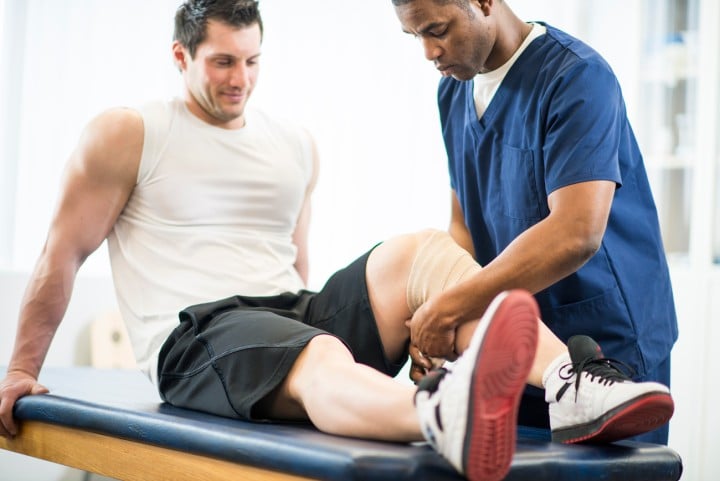
Moving houses can be an exciting but physically demanding endeavor. From lifting heavy boxes to maneuvering furniture, the potential for injury is real. Luckily, with the right stretches and exercises, you can minimize the risk of injury and make the moving process smoother. Here, we want to discuss some of the best stretches and exercises to do before the big move to help prevent injury and keep you and those helping you safe.
Common Injuries Associated With Moving
Back Injuries:
Strains and Sprains: Lifting heavy objects improperly can strain the muscles and ligaments in your back. The sudden or incorrect movement of your spine can lead to a painful sprain or strain.
Herniated Discs: Excessive pressure on the spine, especially when lifting heavy items, can cause the discs between your vertebrae to rupture or herniate. This can result in severe back pain, numbness, and weakness.
Shoulder Injuries:
Rotator Cuff Injuries: Overhead lifting, such as carrying heavy boxes, can strain or tear the rotator cuff tendons in your shoulder, leading to pain and limited mobility.
Tendonitis: Repeated lifting and carrying can cause inflammation in the tendons of your shoulders, resulting in tendonitis and discomfort.
Knee and Leg Injuries:
Strained Muscles: Picking up heavy items and moving quickly can lead to muscle strains in your legs and knees, causing pain and limiting your ability to move.
Knee Injuries: Awkward movements or sudden twists while carrying heavy objects can lead to knee injuries, such as ligament tears or meniscus damage.
Hand and Wrist Injuries:
Carpal Tunnel Syndrome: Repetitive movements like packing and unpacking boxes can strain the wrist and lead to carpal tunnel syndrome, causing pain, numbness, and weakness in the hand.
Tendon Injuries: Excessive gripping and lifting can lead to tendon injuries in the hand and wrist, resulting in pain and limited dexterity.
Strains and Sprains:
Ankle Injuries: Tripping or stumbling over objects, uneven terrain, or stairs during the move can result in ankle sprains or strains.
Cuts, Bruises, and Abrasions:
Minor Injuries: Handling boxes and furniture can expose you to sharp edges, splinters, or heavy items that may fall or shift unexpectedly, leading to minor injuries like cuts, bruises, and abrasions.
Overexertion and Fatigue:
Heat Exhaustion: Moving on a hot day without taking breaks and staying hydrated can lead to heat exhaustion, characterized by symptoms like dizziness, weakness, and nausea.
Dehydration: Failure to drink enough fluids during the move can result in dehydration, leading to fatigue and muscle cramps. In worst-case scenarios, dehydration can even lead to hospitalization and even death.
High-Impact Injuries:
Head Injuries: As noted by Austin brain injury lawyers, head injuries are typically the result of heavy impacts to the head. In the case of moving, this could be from slips, falling down stairs, dropping heavy objects, and more.
Stretches/Exercises To Prepare Your Body
Before you dive into the heavy lifting, it’s essential to warm up your muscles and increase blood flow. Spend a few minutes doing these simple stretches:
Warm Ups
Neck Rolls: Gently roll your neck in both directions to relieve tension and warm up your neck and shoulder muscles.
Shoulder Rolls: Roll your shoulders forward and backward to loosen up your upper body.
Arm Swings: Swing your arms in circles to prepare your arms and shoulders for lifting.
Torso Twists: Stand with your feet hip-width apart and twist your torso gently from side to side to warm up your back muscles.
Hip Circles: Rotate your hips in circles to warm up your lower back and hips.
Leg Stretches:
Moving often involves a lot of squatting, bending, and lifting, which can put strain on your leg muscles and lower back. These stretches will help:
Quad Stretch: Stand on one leg, bend the other leg behind you, and grasp your ankle with your hand. Hold for 15-30 seconds on each leg.
Hamstring Stretch: Sit on the floor with one leg extended and the other leg bent so the sole of your foot is against the inner thigh of your extended leg. Reach forward towards your toes and hold for 15-30 seconds on each leg.
Calf Stretch: Stand facing a wall, place your hands on it, and step one foot back while keeping it straight. Lean forward slightly to feel a stretch in your calf. Hold for 15-30 seconds on each leg.
Core Strengthening:
A strong core is crucial for maintaining proper posture and protecting your back during lifting. Incorporate these exercises into your routine:
Planks: Start with a basic plank position, holding your body in a straight line from head to heels. Hold for 30 seconds to 1 minute, gradually increasing the time as you get stronger.
Dead Bugs: Lie on your back with your arms extended towards the ceiling and your knees bent at a 90-degree angle. Lower your right arm and left leg simultaneously while keeping your lower back pressed into the floor. Return to the starting position and repeat with the opposite arm and leg.
Shoulder and Arm Strengthening:
Your shoulders and arms will get a workout during the moving process, so it’s essential to strengthen these areas:
Push-Ups: Start with modified push-ups if needed and gradually work up to full push-ups. These will strengthen your chest, shoulders, and arms.
Dumbbell Rows: Holding a dumbbell in each hand, bend at the waist with your knees slightly bent. Pull the dumbbells up towards your hips, squeezing your shoulder blades together.
Back Stretches:
Moving heavy objects can strain your back, so it’s vital to keep it flexible and strong:
Child’s Pose: Kneel on the floor with your big toes touching and knees spread apart. Sit back on your heels, reach your arms forward, and lower your chest to the ground.
Cat-Cow Stretch: Get on your hands and knees, inhale as you arch your back (cow pose), and exhale as you round your back (cat pose). This will help maintain flexibility in your spine.
Remember to stay hydrated throughout the moving process and take regular breaks to avoid overexertion. If you’re dealing with particularly heavy or cumbersome items, consider enlisting the help of friends, family, or professional movers to reduce the risk of injury further.
Preparing your body with proper stretches and exercises before moving houses is essential for injury prevention. Incorporating these routines into your moving day will not only help you avoid strain and injury but also make the entire process more manageable and less stressful. So, take care of your body, stay safe, and enjoy your new home!
We hope you found this blog post on How To Avoid Bodily Injury During The Big Move, useful. Be sure to check out our post on Common Mistakes People Make When Moving for more great tips!
Have Experience in the Moving Industry? Want an Additional Income Stream? Work With All Around Moving!
Calling the moving relocation consultants to join this unique opportunity. Working with us will enable you to earn money. We share the profits 50/50 on all jobs booked with us. Click here to learn more.





